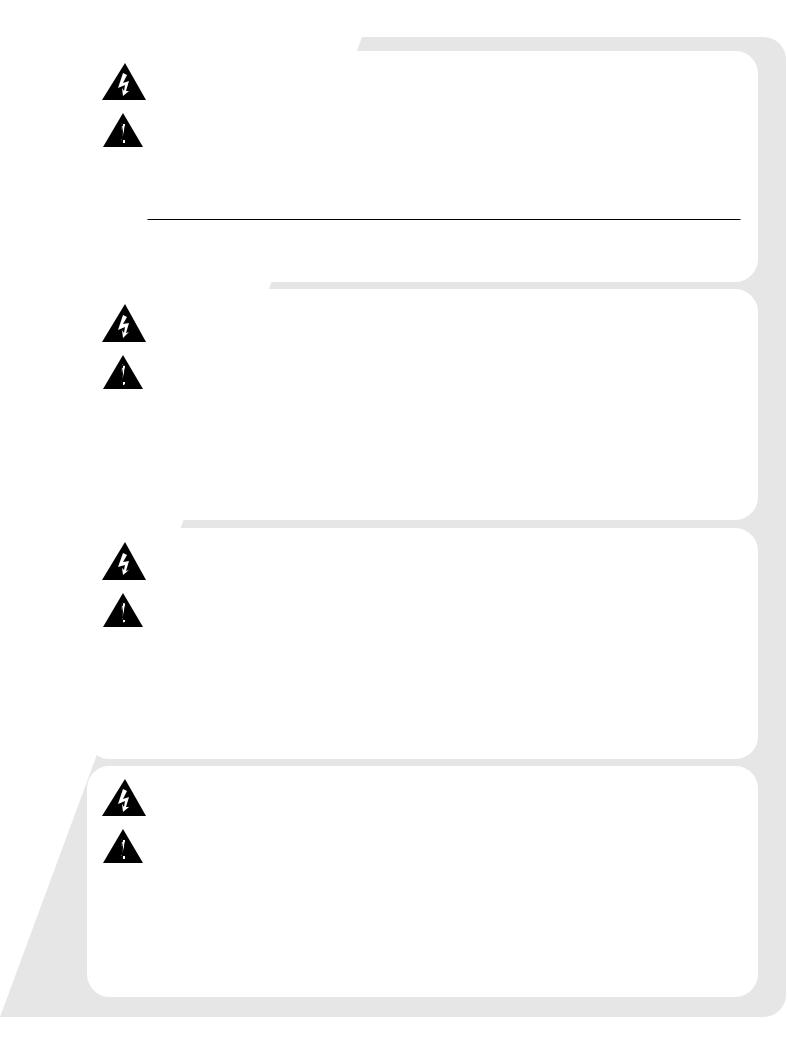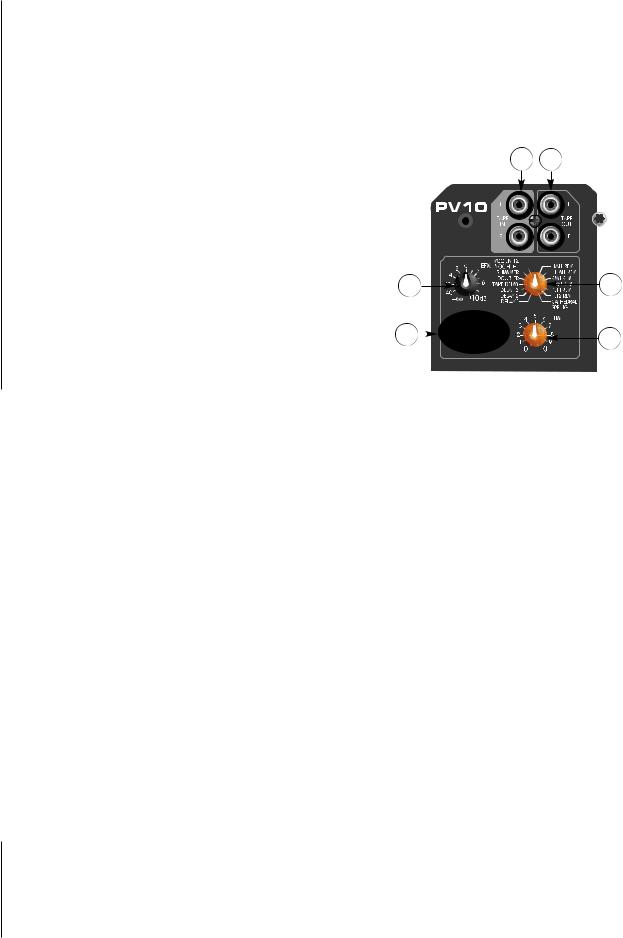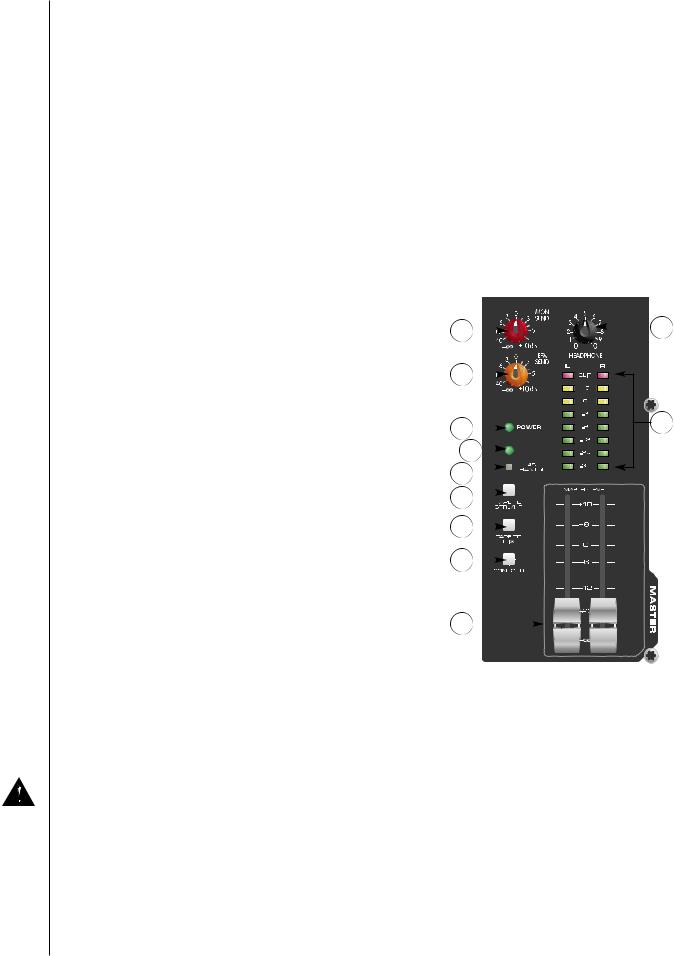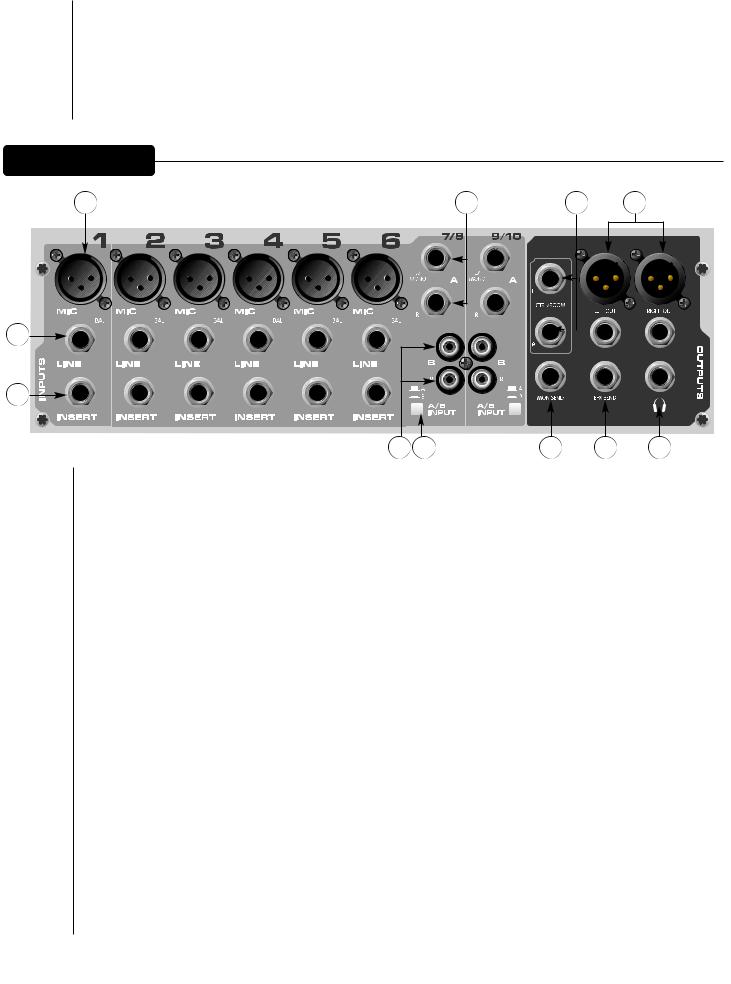Peavey PV 10, PV 14 User Manual

PV®10 and PV®14 Compact Mixer Operations Guide
For more information on other great Peavey products, visit your local Peavey dealer or go online to www.peavey.com

Intended to alert the user to the presence of uninsulated “dangerous voltage” within the product’s enclosure that may be of sufficient magnitude to constitute a risk of electric shock to persons.
Intended to alert the user of the presence of important operating and maintenance (servicing) instructions in the literature accompanying the product.
CAUTION: Risk of electrical shock — DO NOT OPEN!
CAUTION: To reduce the risk of electric shock, do not remove cover. No user serviceable parts inside. Refer servicing to qualified service personnel.
WARNING: To prevent electrical shock or fire hazard, do not expose this appliance to rain or moisture. Before using this appliance, read the operating guide for further warnings.
Este símbolo tiene el propósito, de alertar al usuario de la presencia de “(voltaje) peligroso” sin aislamiento dentro de la caja del producto y que puede tener una magnitud suficiente como para constituir riesgo de descarga eléctrica.
Este símbolo tiene el propósito de alertar al usario de la presencia de instruccones importantes sobre la operación y mantenimiento en la información que viene con el producto.
PRECAUCION: Riesgo de descarga eléctrica ¡NO ABRIR!
PRECAUCION: Para disminuír el riesgo de descarga eléctrica, no abra la cubierta. No hay piezas útiles dentro. Deje todo mantenimiento en manos del personal técnico cualificado.
ADVERTENCIA: Para evitar descargas eléctricas o peligro de incendio, no deje expuesto a la lluvia o humedad este aparato Antes de usar este aparato, Iea más advertencias en la guía de operación.
Ce symbole est utilisé dans ce manuel pour indiquer à l’utilisateur la présence d’une tension dangereuse pouvant être d’amplitude suffisante pour constituer un risque de choc électrique.
Ce symbole est utilisé dans ce manuel pour indiquer à l’utilisateur qu’il ou qu’elle trouvera d’importantes instructions concernant l’utilisation et l’entretien de l’appareil dans le paragraphe signalé.
ATTENTION: Risques de choc électrique — NE PAS OUVRIR!
ATTENTION: Afin de réduire le risque de choc électrique, ne pas enlever le couvercle. Il ne se trouve à l’intérieur aucune pièce pouvant être reparée par l’utilisateur. Confiez I’entretien et la réparation de l’appareil à un réparateur Peavey agréé.
AVERTISSEMENT: Afin de prévenir les risques de décharge électrique ou de feu, n’exposez pas cet appareil à la pluie ou à l’humidité. Avant d’utiliser cet appareil, lisez attentivement les avertissements supplémentaires de ce manuel.
Dieses Symbol soll den Anwender vor unisolierten gefährlichen Spannungen innerhalb des Gehäuses warnen, die von Ausreichender Stärke sind, um einen elektrischen Schlag verursachen zu können.
Dieses Symbol soll den Benutzer auf wichtige Instruktionen in der Bedienungsanleitung aufmerksam machen, die Handhabung und Wartung des Produkts betreffen.
VORSICHT: Risiko — Elektrischer Schlag! Nicht öffnen!
VORSICHT: Um das Risiko eines elektrischen Schlages zu vermeiden, nicht die Abdeckung enfernen. Es befinden sich keine Teile darin, die vom Anwender repariert werden könnten. Reparaturen nur von qualifiziertem Fachpersonal durchführen lassen.
ACHTUNG: Um einen elektrischen Schlag oder Feuergefahr zu vermeiden, sollte dieses Gerät nicht dem Regen oder Feuchtigkeit ausgesetzt werden. Vor Inbetriebnahme unbedingt die Bedienungsanleitung lesen.
2

IMPORTANT SAFETY INSTRUCTIONS
WARNING: When using electrical products, basic cautions should always be followed, including the following:
1.Read these instructions.
2.Keep these instructions.
3.Heed all warnings.
4.Follow all instructions.
5.Do not use this apparatus near water.
6.Clean only with a dry cloth.
7.Do not block any of the ventilation openings. Install in accordance with manufacturer’s instructions.
8.Do not install near any heat sources such as radiators, heat registers, stoves or other apparatus (including amplifiers) that produce heat.
9.Do not defeat the safety purpose of the polarized or grounding-type plug. A polarized plug has two blades with one wider than the other. A grounding type plug has two blades and a third grounding plug. The wide blade or third prong is provided for your safety. If the provided plug does not fit into your outlet, consult an electrician for replacement of the obsolete outlet.
10.Protect the power cord from being walked on or pinched, particularly at plugs, convenience receptacles, and the point they exit from the apparatus.
11.Note for UK only: If the colors of the wires in the mains lead of this unit do not correspond with the terminals in your plug‚ proceed as follows:
a)The wire that is colored green and yellow must be connected to the terminal that is marked by the letter E‚ the earth symbol‚ colored green or colored green and yellow.
b)The wire that is colored blue must be connected to the terminal that is marked with the letter N or the color black.
c)The wire that is colored brown must be connected to the terminal that is marked with the letter L or the color red.
12.Only use attachments/accessories provided by the manufacturer.
13.Use only with a cart, stand, tripod, bracket, or table specified by the manufacturer, or sold with the apparatus. When
a cart is used, use caution when moving the cart/apparatus combination to avoid injury from tip-over.
14.Unplug this apparatus during lightning storms or when unused for long periods of time.
15.Refer all servicing to qualified service personnel. Servicing is required when the apparatus has been damaged in any way, such as power-supply cord or plug is damaged, liquid has been spilled or objects have fallen into the apparatus, the apparatus has been exposed to rain or moisture, does not operate normally, or has been dropped.
16.Never break off the ground pin. Write for our free booklet “Shock Hazard and Grounding.” Connect only to a power supply of the type marked on the unit adjacent to the power supply cord.
17.If this product is to be mounted in an equipment rack, rear support should be provided.
18.Exposure to extremely high noise levels may cause a permanent hearing loss. Individuals vary considerably in susceptibility to noise-induced hearing loss, but nearly everyone will lose some hearing if exposed to sufficiently intense noise for a sufficient time. The U.S. Government’s Occupational and Health Administration (OSHA) has specified the following permissible noise level exposures:
Duration Per Day In Hours |
Sound Level dBA, Slow Response |
8 |
90 |
6 |
92 |
4 |
95 |
3 |
97 |
2 |
100 |
1 1⁄2 |
102 |
1 |
105 |
1⁄2 |
110 |
1⁄4 or less |
115 |
According to OSHA, any exposure in excess of the above permissible limits could result in some hearing loss. Ear plugs or protectors to the ear canals or over the ears must be worn when operating this amplification system in order to prevent a permanent hearing loss, if exposure is in excess of the limits as set forth above. To ensure against potentially dangerous exposure to high sound pressure levels, it is recommended that all persons exposed to equipment capable of producing high sound pressure levels such as this amplification system be protected by hearing protectors while this unit is in operation.
SAVE THESE INSTRUCTIONS!
3

WICHTIGE SICHERHEITSHINWEISE
ACHTUNG: Beim Einsatz von Elektrogeräten müssen u.a. grundlegende Vorsichtsmaßnahmen befolgt werden:
1.Lesen Sie sich diese Anweisungen durch.
2.Bewahren Sie diese Anweisungen auf.
3.Beachten Sie alle Warnungen.
4.Befolgen Sie alle Anweisungen.
5.Setzen Sie dieses Gerät nicht in der Nähe von Wasser ein.
6.Reinigen Sie es nur mit einem trockenen Tuch.
7.Blockieren Sie keine der Lüftungsöffnungen. Führen Sie die Installation gemäß den Anweisungen des Herstellers durch.
8.Installieren Sie das Gerät nicht neben Wärmequellen wie Heizungen, Heizgeräten, Öfen oder anderen Geräten (auch Verstärkern), die Wärme erzeugen.
9.Beeinträchtigen Sie nicht die Sicherheitswirkung des gepolten Steckers bzw. des Erdungssteckers. Ein gepolter Stecker weist zwei Stifte auf, von denen einer breiter ist als der andere. Ein Erdungsstecker weist zwei Stifte und einen dritten Erdungsstift auf. Der breite Stift bzw. der dritte Stift dient Ihrer Sicherheit. Sollte der beiliegende Stecker nicht in Ihre Steckdose passen, wenden Sie sich bitte an einen Elektriker, um die ungeeignete Steckdose austauschen zu lassen.
10.Schützen Sie das Netzkabel, sodass niemand darauf tritt oder es geknickt wird, insbesondere an Steckern oder Buchsen und ihren Austrittsstellen aus dem Gerät.
11.Hinweis – Nur für Großbritannien: Sollte die Farbe der Drähte in der Netzleitung dieses Geräts nicht mit den Klemmen in Ihrem Stecker übereinstimmen, gehen Sie folgendermaßen vor:
a)Der grün-gelbe Draht muss an die mit E (Symbol für Erde) markierte bzw. grüne oder grün-gelbe Klemme angeschlossen werden.
b)Der blaue Draht muss an die mit N markierte bzw. schwarze Klemme angeschlossen werden.
c)Der braune Draht muss an die mit L markierte bzw. rote Klemme angeschlossen werden.
12.Verwenden Sie nur die vom Hersteller erhältlichen Zubehörgeräte oder Zubehörteile.
13.Verwenden Sie nur einen Wagen, Stativ, Dreifuß, Träger oder Tisch, der den Angaben des Herstellers entspricht oder zusammen
mit dem Gerät verkauft wurde. Wird ein Wagen verwendet, bewegen Sie den Wagen mit dem darauf befindlichen Gerät besonders vorsichtig, damit er nicht umkippt und möglicherweise jemand verletzt wird.
14.Trennen Sie das Gerät während eines Gewitters oder während längerer Zeiträume, in denen es nicht benutzt wird, von der Stromversorgung.
15.Lassen Sie sämtliche Wartungsarbeiten von qualifizierten Kundendiensttechnikern durchführen. Eine Wartung ist erforderlich, wenn das Gerät in irgendeiner Art beschädigt wurde, etwa wenn das Netzkabel oder der Netzstecker beschädigt wurden, Flüssigkeit oder Gegenstände in das Gerät gelangt sind, das Gerät Regen oder Feuchtigkeit ausgesetzt wurde, nicht normal arbeitet oder heruntergefallen ist.
16.Der Erdungsstift darf nie entfernt werden. Auf Wunsch senden wir Ihnen gerne unsere kostenlose Broschüre „Shock Hazard and Grounding“ (Gefahr durch elektrischen Schlag und Erdung) zu. Schließen Sie nur an die Stromversorgung der Art an, die am Gerät neben dem Netzkabel angegeben ist.
17.Wenn dieses Produkt in ein Geräte-Rack eingebaut werden soll, muss eine Versorgung über die Rückseite eingerichtet werden.
18.Belastung durch extrem hohe Lärmpegel kann zu dauerhaftem Gehörverlust führen. Die Anfälligkeit für durch Lärm bedingten Gehörverlust ist von Mensch zu Mensch verschieden, das Gehör wird jedoch bei jedem in gewissem Maße geschädigt, der über einen bestimmten Zeitraum ausreichend starkem Lärm ausgesetzt ist. Die US-Arbeitsschutzbehörde (Occupational and Health Administration, OSHA) hat die folgenden zulässigen Pegel für Lärmbelastung festgelegt:
Dauer pro Tag in Stunden |
Geräuschpegel dBA, langsame Reaktion |
8 |
90 |
6 |
92 |
4 |
95 |
3 |
97 |
2 |
100 |
1 1⁄2 |
102 |
1 |
105 |
1⁄2 |
110 |
1⁄4 oder weniger |
115 |
Laut OSHA kann jede Belastung über den obenstehenden zulässigen Grenzwerten zu einem gewissen Gehörverlust führen. Sollte die Belastung die obenstehenden Grenzwerte übersteigen, müssen beim Betrieb dieses Verstärkungssystems Ohrenstopfen oder Schutzvorrichtungen im Gehörgang oder über den Ohren getragen werden, um einen dauerhaften Gehörverlust zu verhindern. Um sich vor einer möglicherweise gefährlichen Belastung durch hohe Schalldruckpegel zu schützen, wird allen Personen empfohlen, die mit Geräten arbeiten, die wie dieses Verstärkungssystem hohe Schalldruckpegel erzeugen können, beim Betrieb dieses Geräts einen Gehörschutz zu tragen.
BEWAHREN SIE DIESE SICHERHEITSHINWEISE AUF!
4

INSTRUCTIONS IMPORTANTES DE SECURITE
ATTENTION: L’utilisation de tout appareil électrique doit être soumise aux precautions d’usage incluant:
1.Lire ces instructions.
2.Gardez ce manuel pour de futures références.
3.Prétez attention aux messages de précautions de ce manuel.
4.Suivez ces instructions.
5.N’utilisez pas cette unité proche de plans d’eau.
6.N’utilisez qu’un tissu sec pour le nettoyage de votre unité.
7.N’obstruez pas les systèmes de refroidissement de votre unité et installez votre unité en fonction des instructions de ce manuel.
8.Ne positionnez pas votre unité à proximité de toute source de chaleur.
9.Connectez toujours votre unité sur une alimentation munie de prise de terre utilisant le cordon d’alimentation fourni.
10.Protégez les connecteurs de votre unité et positionnez les cablages pour éviter toutes déconnexions accidentelles.
11.Note pour les Royaumes-Unis: Si les couleurs de connecteurs du cable d’alimentation ne correspond pas au guide de la prise secteur, procédez comme suit:
a)Le connecteur vert et jaune doit être connectrer au terminal noté E, indiquant la prise de terre ou correspondant aux couleurs verte ou verte et jaune du guide.
b)Le connecteur Bleu doit être connectrer au terminal noté N, correspondnat à la couleur noire du guide.
c)Le connecteur marron doit être connectrer au terminal noté L, correspondant à la couleur rouge du guide..
12.N’utilisez que des fixations approuvées par le fabriquant.
13.Lors de l’utilsation sur pied ou pole de support, assurez dans le cas de déplacement de l’ensemble
enceinte/support de prévenir tout basculement intempestif de celui-ci.
14.Il est conseillé de déconnecter du secteur votre unité en cas d’orage ou de durée prolongée sans utilisation.
15.Seul un technicien agréé par le fabriquant est à même de réparer/contrôler votre unité. Celle-ci doit être contrôlée si elle a subit des dommages de manipulation, d’utilisation ou de stockage (humidité,…).
16.Ne déconnectez jamais la prise de terre de votre unité.
17.Si votre unité est destinée a etre montée en rack, des supports arriere doivent etre utilises.
18.Une exposition à de hauts niveaux sonores peut conduire à des dommages de l’écoute irréversibles. La susceptibilité au bruit varie considérablement d’un individu à l’autre, mais une large majorité de la population expériencera une perte de l’écoute après une exposition à une forte puissance sonore pour une durée prolongée. L’organisme de la santé américaine (OSHA) a produit le guide ci-dessous en rapport à la perte occasionnée:
Durée par Jour (heures) |
Niveau sonore moyen (dBA) |
8 |
90 |
6 |
92 |
4 |
95 |
3 |
97 |
2 |
100 |
1 1⁄2 |
102 |
1 |
105 |
1⁄2 |
110 |
1⁄4 ou inférieur |
115 |
D’après les études menées par le OSHA, toute exposition au delà des limites décrites ce-dessus entrainera des pertes de l’écoute chez la plupart des sujets. Le port de système de protection (casque, oreilette de filtrage,…) doit être observé lors de l’opération cette unité ou des dommages irréversibles peuvent être occasionnés. Le port de ces systèmes doit être observé par toutes personnes susceptibles d’être exposées à des conditions au delà des limites décrites ci-dessus.
GARDEZ CES INSTRUCTIONS!
5

INSTRUCCIONES IMPORTANTES PARA SU SEGURIDAD
CUIDADO: Cuando use productos electrónicos, debe tomar precauciones básicas, incluyendo las siguientes:
1.Lea estas instrucciones.
2.Guarde estas instrucciones.
3.Haga caso de todos los consejos.
4.Siga todas las instrucciones.
5.No usar este aparato cerca del agua.
6.Limpiar solamente con una tela seca.
7.No bloquear ninguna de las salidas de ventilación. Instalar de acuerdo a las instrucciones del fabricante.
8.No instalar cerca de ninguna fuente de calor como radiadores, estufas, hornos u otros aparatos (incluyendo amplificadores) que produzcan calor.
9.No retire la patilla protectora del enchufe polarizado o de tipo “a Tierra”. Un enchufe polarizado tiene dos puntas, una de ellas más ancha que la otra. Un enchufe de tipo “a Tierra” tiene dos puntas y una tercera “a Tierra”. La punta ancha ( la tercera ) se proporciona para su seguridad. Si el enchufe proporcionado no encaja en su enchufe de red, consulte a un electricista para que reemplaze su enchufe obsoleto.
10.Proteja el cable de alimentación para que no sea pisado o pinchado, particularmente en los enchufes, huecos, y los puntos que salen del aparato.
11.Nota para el Reino Unido solamente: Si los colores de los cables en el enchufe principal de esta unidad no corresponden con los terminales en su enchufe‚ proceda de la siguiente manera:
a)El cable de color verde y azul debe ser conectado al terminal que está marcado con la letra E‚ el símbolo de Tierra (earth)‚ coloreado en verde o en verde y amarillo.
b)El cable coloreado en azul debe ser conectado al terminal que está marcado con la letra N o el color negro.
c)El cable coloreado en marrón debe ser conectado al terminal que está marcado con la letra L o el color rojo.
12.Usar solamente añadidos/accesorios proporcionados por el fabricante.
13.Usar solamente un carro, pie, trípode, o soporte especificado por el fabricante, o vendido junto al aparato. Cuando se use
un carro, tenga cuidado al mover el conjunto carro/aparato para evitar que se dañe en un vuelco. No suspenda esta caja de ninguna manera.
14.Desenchufe este aparato durante tormentas o cuando no sea usado durante largos periodos de tiempo.
15.Para cualquier reparación, acuda a personal de servicio cualificado. Se requieren reparaciones cuando el aparato ha sido dañado de alguna manera, como cuando el cable de alimentación o el enchufe se han dañado, algún líquido ha sido derramado o algún objeto ha caído dentro del aparato, el aparato ha sido expuesto a la lluvia o la humedad, no funciona de manera normal, o ha sufrido una caída.
16.Nunca retire la patilla de Tierra.Escríbanos para obtener nuestro folleto gratuito “Shock Hazard and Grounding” (“Peligro de Electrocución y Toma a Tierra”). Conecte el aparato sólo a una fuente de alimentación del tipo marcado al lado del cable de alimentación.
17.Si este producto va a ser enracado con más equipo, use algún tipo de apoyo trasero.
18.La exposición a altos niveles de ruido puede causar una pérdida permanente en la audición. La susceptibilidad a la pérdida de audición provocada por el ruido varía según la persona, pero casi todo el mundo perderá algo de audición si se expone a un nivel de ruido suficientemante intenso durante un tiempo determinado. El Departamento para la Salud y para la Seguridad del Gobierno de los Estados Unidos (OSHA) ha especificado las siguientes exposiciones al ruido permisibles:
Duración por Día en Horas |
Nivel de Sonido dBA, Respuesta Lenta |
8 |
90 |
6 |
92 |
4 |
95 |
3 |
97 |
2 |
100 |
1 1⁄2 |
102 |
1 |
105 |
1⁄2 |
110 |
1⁄4 o menos |
115 |
De acuerdo al OSHA, cualquier exposición que exceda los límites arriba indicados puede producir algún tipo de pérdida en la audición. Protectores para los canales auditivos o tapones para los oídos deben ser usados cuando se opere con este sistema de sonido para prevenir una pérdida permanente en la audición, si la exposición excede los límites indicados más arriba. Para protegerse de una exposición a altos niveles de sonido potencialmente peligrosa, se recomienda que todas las personas expuestas a equipamiento capaz de producir altos niveles de presión sonora, tales como este sistema de amplificación, se encuentren protegidas por protectores auditivos mientras esta unidad esté operando.
GUARDE ESTAS INSTRUCCIONES!
6

ENGLISH
PV®10 and PV®14 Compact Mixers
Description
Congratulations on purchasing the Peavey PV 10 or PV 14 compact mixer. The PV 10 and PV 14 are studio-quality mixing consoles designed to meet diverse needs while occupying only a small space. These are the perfect consoles for small venue performances or home recording environments. PV series mixers feature built-in DSP effects that are useful in real-world recording and sound reinforcement, and parameter controls allow you to tailor each effect to meet your needs.
Please read this guide carefully to ensure your personal safety as well as the safety of your equipment.
Features
Six XLR mic inputs on PV 10, ten XLR mic inputs on PV 14
Two stereo channels with RCA and 1⁄4" inputs
Three-band channel EQ
A/B stereo input selector reduces patching
Inserts on all mono channels
80 Hz low-cut switch on all mic inputs
Clip LEDs monitor the entire signal path for clipping
Signal LEDs on every input channel
Mute switches with LED indicator on every input channel
48 Volt phantom power switch
Effects send on every channel with stereo return
Internal digital effects with 16 selections, including reverb, delay and vocal enhancement
Effect parameter adjustment allows you to customize each effect selection
Monitor send on every channel
Zero latency record monitoring capabilities
Control room output with level control
Contour EQ switch
Internal universal input power supply
Optional rack-mount kit
7

F R O N T P A N E L
Gain (1)
This control establishes the nominal operating level for the channel. The input gain can be adjusted over a wide range to compensate for soft voices or very loud drums. To maximize the signal-to-noise ratio, the gain should be set to the proper level, with the channel level control (12) set to 0. If the clip LED comes on and remains lit, try reducing the gain.
80 Hz Low Cut (2)
The low cut filter has a corner frequency of 80 Hz. When engaged‚ it can improve clarity by removing low frequencies that make a mix sound muddy. This feature is especially useful when playing outside on a windy day or on a hollow-sounding‚ noisy stage. These kinds of ambient noises can rob your sound system of power. Engaging this switch will remove those frequencies from the system and restore power where needed.
Hi EQ (3)
An active tone control (shelving type: ±15 dB) that varies the level of the high frequency range.
Mid EQ (4)
An active tone control (peak dip: ±15 dB) that varies the mid frequency range.
1
2
3
4
5
6
7
8
10 |
9 |
|
|
11 |
|
Low EQ (5)
An active tone control (shelving type: ±15 dB) that varies the level of the low frequency range.
Caution: Excessive low frequency boost causes greater power consumption and increases the |
12 |
possibility of speaker damage. |
|
MON Send (6)
This control adjusts the level of the channel signal sent to the monitor output. The signal is taken before the channel level control but after the channel EQ.
EFX Send (7)
This control adjusts the level of the channel signal added to the effects mix. The effects send signal is taken after the channel fader (12) so that adjustments made to the fader will also affect the send level.
Pan (8)
This knob controls the placement of the signal in the stereo field. When rotated completely counterclockwise‚ the signal is present only on the left channel; when rotated completely clockwise‚ only in the right channel. On stereo channels 5/6 and 7/8 on the PV 10, (11/12 and 13/14 on the PV 14), this control functions as a balance control to adjust the relative level of the left and right signals.
Mute (9)
The mute button is a quick way to remove the channel signal from the left/right main mix, effects and monitor sends without disturbing the control setting.
Clip/Mute LED (10)
This light normally indicates that the channel signal level is nearing the overload point, but it also lights when mute is engaged. The clip indicator circuit monitors the signal at many points in the channel to ensure that it catches all instances of clipping. It illuminates at +19 dBu and warns that the gain or EQ boost should be reduced. When it lights, roughly 3 dB of headroom remain.
8

Signal LED (11)
The signal LED lights when the channel level reaches approximately -20 dBu. This not only indicates which channels are active, but also serves as a mini level meter.
Fader (12)
The channel fader is the channel output control and sets the signal level to the left and right mix and the effects send control. The optimum setting is the 0 (unity gain) position.
13 14
Tape In/Out (13 & 14)
The tape input jacks are designed to accommodate tape‚ CD or computer sound card output levels. The output level is +4 dBu for connecting to a recorder or sound card input. The tape inputs can be used as an additional stereo input by engaging the Tape to Main Mix switch (27). The tape input can also be used to monitor the recorder/sound card output without the risk of feedback.
18
EFX Select (15)
This rotary switch selects one of sixteen available effects. See the
17
table below for descriptions of each.
15
16
|
Effect |
Description |
Application |
Parameter |
|
|
|
|
|
1 |
Hall Rev |
Medium Concert Hall |
Ensemble |
Rev Time |
|
|
|
|
|
2 |
Large Hall Rev |
Larger Concert Hall Darker |
Gen Reverb |
Rev Time |
3 |
Room 1 Rev |
Intimate Room Bright |
Pop Vocal |
Rev Time |
4 |
Room 2 Rev |
Larger Room Darker |
Drums, Rhythm |
Rev Time |
5 |
Plate 1 Rev |
Bright |
Pop Vocal |
Rev Time |
6 |
Plate 2 Rev |
Darker |
Drums |
Rev Time |
7 |
Cathedral |
Large Space, Long and Darker |
Choir |
Rev Time |
8 |
Spring |
Classic Spring |
Guitar |
Rev Time |
9 |
Delay 1 |
Single Delay (Slap-back) |
Voc/Instr |
Dly Time |
10 |
Delay 2 |
Warm Delay with Repeats |
Instruments |
Dly Time |
11 |
Delay 3 |
Dark Delay with Repeats |
Instruments |
Dly Time |
12 |
Tape Delay |
Warm Delay |
Instruments |
Dly Time/Feedback |
13 |
Doubler |
Single Delay, 30 - 120 ms |
Instruments |
Dly Time |
14 |
Shimmer |
Warm Delay with Modulation |
Instruments |
Dly Time |
15 |
Vocal Enhancement 1 |
Brightens and adds Room Reverb |
Vocals |
Rev Level |
16 |
Vocal Enhancement 2 |
Brightens and adds Spring Reverb |
Vocals |
Rev Level |
EFX Time (16)
This control adjusts the time of the particular reverb or delay.
9

Green Signal LED and Red Clip LED (17)
The green Signal LED and red Clip LED are used to set the operating input level to the PV®10 and PV®14 effects processors. The signal level to the processor is affected by channel fader, the effects send and the effects send master controls. Start with the master control set to 0 (12 o'clock) and adjust the channel sends so that the signal LED lights and the clip LED blinks on occasionally, if at all. The clip LED lights 6 db below clipping. Pressing the EFX defeat mutes the effects signal and lights the clip/mute LED.
EFX Return (18)
Once the input level is set (see 17) use the EFX return control to mix the effects processor output into the main left/right outputs. Remember, a little reverb goes a long way.
MON Send Master (19)
This is the master output level control for the monitor mix. The output level sent to the Monitor Send jack (36) is controlled by the channel monitor send controls (6) and by this master control.
EFX Send Master (20)
This is the master output level control for the EFX mix. The output |
|
|
|
|
|
|
|
|
|
|
|
|
level sent to the EFX Send jack and the internal effects processor is |
|
|
|
|
|
|
|
|
|
|
|
|
controlled by the channel level controls (12), the channel EFX send |
19 |
|
|
|
|
|
|
|
|
|
|
|
|
|
|
|
|
|
|
|
|
|
|
||
|
|
|
|
|
|
|
|
|
|
|
||
controls (7) and by this master control. The 0 position is the |
|
|
|
|
|
|
|
|
|
|
|
|
|
|
|
|
|
|
|
|
|
|
|
|
|
recommended setting for this control. |
20 |
|
|
|
|
|
|
|
|
|
|
|
|
|
|
|
|
|
|
|
|
|
|
|
Headphone Level (21)
This knob sets the headphone and control room output levels. To |
23 |
|
|
|
|
|
|
|
|
|
|
|
|
|
|
|
|
|
|
|
|
|
|
|
|
|
|
|
|
|
|
|
|
|
|
|
|
||
avoid damage to your hearing‚ make sure to turn the dial fully |
|
|
|
|
|
|
|
|
|
|
|
|
|
|
|
|
|
|
|
counterclockwise before using headphones. Slowly turn the knob |
24 |
|
|
|
|
|
|
|
|
|
|
|
|
|
|
|
|||
|
|
|
|
|
|
|
|
|
|
|
|
|
|
||||||
|
|
|
|
|
|
|
|
|
|
|
|
|
|
|
|||||
clockwise until you reach a comfortable listening level. Normally, the |
25 |
|
|
|
|
|
|
|
|
|
|
|
|
|
|
|
|
|
|
|
|
|
|
|
|
|
|
|
|
|
|
|
|
|
|
|
|
||
signal in the headphones is the left/right signal. If the Tape to Control |
|
|
|
|
|
|
|
|
|
|
|
|
|
|
|
|
|
|
|
|
|
|
|
|
|
|
|
|
|
|
|
|
|
||||||
|
|
|
|
|
|
|
|
|
|
|
|
|
|
|
|
|
|
|
|
Room (26) is engaged‚ the tape signal is also included. |
26 |
|
|
|
|
|
|
|
|
|
|
|
|
|
|
|
|
|
|
|
|
|
|
|
|
|
|
|
|
|
|
|
|
|
|
|
|
||
|
|
|
|
|
|
|
|
|
|
|
|
|
|
||||||
LED Meters (22) |
27 |
|
|
|
|
|
|
|
|
|
|
|
|
|
|
|
|
|
|
|
|
|
|
|
|
|
|
|
|
|
|
|
|
|
|
|
|
||
|
|
|
|
|
|
|
|
|
|
|
|
|
|
|
|
|
|
||
|
|
|
|
|
|
|
|
|
|
|
|
|
|
|
|
|
|
||
|
|
|
|
|
|
|
|
|
|
|
|
|
|
|
|
|
|
|
|
Two eight-segment LED arrays are provided to monitor the levels of |
28 |
|
|
|
|
|
|
|
|
|
|
|
|
|
|
|
|
|
|
|
|
|
|
|
|
|
|
|
|
|
|
|
|
|
|
|
|
||
the main left/right outputs. These meters range from -30 dB to +19 |
|
|
|
|
|
|
|
|
|
|
|
|
|
|
|
|
|
|
|
|
|
|
|
|
|
|
|
|
|
|
|
|
|
|
|
|
|
|
|
dB. 0 dB on the meter corresponds to +4 dBu at the outputs. |
|
|
|
|
|
|
|
|
|
|
|
|
|
|
|
|
|
|
|
Power LED (23) |
29 |
|
|
|
|
|
|
|
|
|
|
|
|
|
|
|
|
|
|
|
|
|
|
|
|
|
|
|
|
|
|
|
|
|
|
|
|
||
This LED indicates AC power is supplied to the unit‚ the power |
|
|
|
|
|
|
|
|
|
|
|
|
|
|
|
|
|
|
|
|
|
|
|
|
|
|
|
|
|
|
|
|
|
|
|
|
|
|
|
switch is on and the unit is functioning properly. |
|
|
|
|
|
|
|
|
|
|
|
|
|
|
|
|
|
|
|
21
22
Phantom Power LED (24)
This LED lights when the Phantom Power Switch (25) has been engaged.
Phantom Power Switch (25)
Applies +48 VDC voltage to the input XLR connectors to power microphones requiring phantom power.
If phantom power is used, do not connect unbalanced dynamic microphones or other devices to the XLR inputs.
Tape To CTRL/HP (26)
Depressing this switch adds the tape return to the Control Room (38) and Headphone Outputs (40) for zero latency monitoring.
Tape to Mix (27)
Depressing this switch routes the signal from the Tape Inputs (13) to the Main Outputs (39).
10

Contour Switch (28)
Engaging this switch enhances the signal by adding both bass and treble frequencies. This is especially effective at lower volumes or for tape/CD playback.
Master Level Faders (29)
The Master Faders control the levels sent to the main left/right outputs. Best results are obtained when these controls are set near the 0 point.
R E A R P A N E L
30 |
33 |
38 |
39 |
31
32
34 |
35 |
36 |
37 |
40 |
Mic (XLR) Inputs (30)
XLR balanced inputs optimized for a microphone or other low impedance source. Pin 2 is the positive input. Because of the wide range of gain adjustment, signal levels up to +14 dBu can be accommodated.
Line (1⁄4”) Inputs (31)
1⁄4” balanced (TRS) 10 k Ohm impedance input. The tip is the positive input and should be used for unbalanced inputs. It has 20 dB less gain than the XLR input and does not have phantom power available. The Mic and Line inputs should not be used simultaneously.
Insert (32)
1⁄4” TRS connector allows external signal processors to be inserted into the channel signal path. Tip=Send; Ring=Return; Sleeve=Ground.
Stereo (1⁄4") Inputs (33)
These 1⁄4" unbalanced inputs work as a stereo line input using both jacks or as a mono input if the connection is made to the left/mono input only. The A/B input selector must be in the "A" position for these jacks to be active.
RCA Inputs (34)
These RCA inputs work as stereo line inputs. The A/B input selector must be in the "B" position for these jacks to be active.
A/B Switch (35)
The A/B input selector switch expands the capability of the PV®10 and the PV®14 mixers by allowing two stereo sources to be connected to each stereo line input. Instead of repatching, the switch selects which input jacks are active.
11
